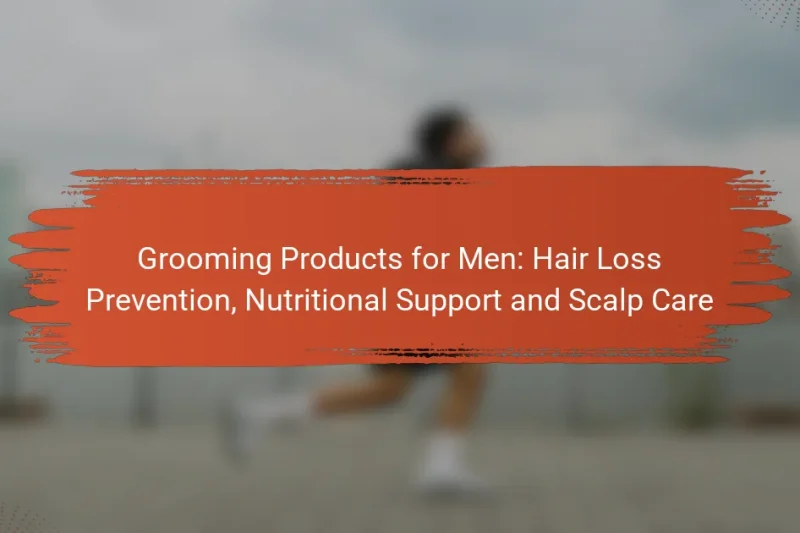Choosing the right grooming products, particularly shampoos, is essential for men to maintain healthy hair and … Grooming Products for Men: Shampoo Selection, Hair Type Compatibility and Scalp HealthRead more
Men’s Hair Care Tips
Taking care of your hair is essential for maintaining a healthy and stylish appearance. From selecting the right products tailored to your hair type to adopting effective strategies for preventing hair loss, understanding the basics of men’s hair care can make a significant difference. Whether you’re looking for the best styling techniques or ways to promote scalp health, these tips will help you achieve your desired look with confidence.
Hair Types: Characteristics, Care Strategies and Product Recommendations
Understanding your hair type is essential for effective care and styling. Different hair types, categorized by … Hair Types: Characteristics, Care Strategies and Product RecommendationsRead more
Grooming Products for Men: Curly Haircuts, Styling Techniques and Maintenance
Men with curly hair can achieve stylish looks and maintain healthy locks by using the right … Grooming Products for Men: Curly Haircuts, Styling Techniques and MaintenanceRead more
Grooming Products for Men: Hair Loss Prevention, Nutritional Support and Scalp Care
Grooming products for men play a vital role in combating hair loss by enhancing scalp health … Grooming Products for Men: Hair Loss Prevention, Nutritional Support and Scalp CareRead more
Grooming Products for Men: Summer Hair Care, Hydration and Protection
As summer approaches, men need to prioritize their hair care with products that offer hydration, lightweight … Grooming Products for Men: Summer Hair Care, Hydration and ProtectionRead more
Hair Styling Products: Pomade, Wax and Texture
When it comes to achieving the perfect hairstyle, choosing the right product is crucial. Pomades, waxes, … Hair Styling Products: Pomade, Wax and TextureRead more
Grooming Products for Men: Thinning Hair Solutions, Styling Options and Nourishing Ingredients
Grooming products for men facing thinning hair offer a range of solutions, from topical treatments to … Grooming Products for Men: Thinning Hair Solutions, Styling Options and Nourishing IngredientsRead more
What are the best hair care products for men in the UK?
The best hair care products for men in the UK include a range of shampoos, conditioners, styling gels, hair oils, and natural products tailored to different hair types and needs. Choosing the right products can enhance hair health, manageability, and style, making it essential to understand what works best for your specific hair type.
Shampoos for oily hair
For men with oily hair, look for shampoos that contain clarifying ingredients such as tea tree oil or salicylic acid. These components help to remove excess oil and buildup without stripping the hair of its natural moisture.
Consider using a shampoo specifically formulated for oily hair two to three times a week. Avoid heavy, moisturizing shampoos, as they can exacerbate oiliness.
Conditioners for dry hair
Men with dry hair should opt for conditioners that provide deep hydration and nourishment. Look for products containing ingredients like argan oil, shea butter, or glycerin, which help to restore moisture and improve hair texture.
Apply conditioner after every shampoo, focusing on the ends of the hair. Leave it on for a few minutes before rinsing to maximize its effectiveness.
Styling gels for all-day hold
For a strong hold throughout the day, choose styling gels that offer a firm but flexible hold. Look for alcohol-free formulas to prevent hair from becoming dry and brittle.
Apply a small amount of gel to damp hair and style as desired. For a more natural look, use a lightweight gel that provides hold without stiffness.
Hair oils for nourishment
Hair oils can significantly enhance the health of your hair by providing essential nutrients and moisture. Oils such as jojoba, coconut, or argan oil are excellent choices for adding shine and reducing frizz.
Use hair oil sparingly, applying a few drops to the palms and working it through the hair, focusing on the ends. This can be done on damp or dry hair for added hydration.
Natural products for sensitive scalps
For men with sensitive scalps, natural hair care products free from harsh chemicals are ideal. Look for shampoos and conditioners that contain soothing ingredients like chamomile, aloe vera, or calendula.
Always perform a patch test before using new products to avoid irritation. Opt for fragrance-free options to minimize the risk of allergic reactions.
How can men prevent hair loss?
Men can prevent hair loss by adopting a combination of effective strategies that promote scalp health and hair growth. Key methods include regular scalp massages, topical treatments like minoxidil, maintaining a nutritious diet, and managing stress levels.
Regular scalp massages
Scalp massages can stimulate blood circulation to hair follicles, promoting hair growth. Aim for a daily routine of 5-10 minutes, using your fingertips to apply gentle pressure in circular motions.
Consider using essential oils such as rosemary or peppermint during your massage, as they may enhance the benefits. Just ensure to dilute them with a carrier oil to avoid irritation.
Minoxidil treatments
Minoxidil is an FDA-approved topical treatment that can help slow hair loss and promote regrowth. It is available over-the-counter in liquid or foam forms, typically applied twice daily.
Results can take several months to appear, and consistency is key. Be aware that discontinuing treatment may lead to a return of hair loss, so consider this commitment before starting.
Healthy diet rich in vitamins
A balanced diet rich in vitamins and minerals is crucial for hair health. Focus on foods high in vitamins A, C, D, E, zinc, iron, and omega-3 fatty acids, such as leafy greens, nuts, fish, and eggs.
Consider incorporating a multivitamin if your diet lacks essential nutrients, but consult with a healthcare provider to ensure it meets your specific needs.
Stress management techniques
Chronic stress can contribute to hair loss, making stress management essential. Techniques such as yoga, meditation, and regular exercise can help reduce stress levels.
Additionally, setting aside time for hobbies and social activities can improve your overall well-being, further supporting healthy hair growth. Aim for at least 30 minutes of physical activity most days to combat stress effectively.
What are effective hairstyles for men?
Effective hairstyles for men vary based on hair type, face shape, and personal style. Choosing the right cut can enhance features and simplify grooming routines.
Short textured cuts
Short textured cuts are versatile and easy to maintain, making them a popular choice among men. Styles like the crew cut or textured crop add dimension and can work well with various hair types. To achieve this look, ask your barber for layers that create texture while keeping the sides and back shorter.
Consider using a lightweight styling product to enhance the texture and provide hold without weighing the hair down. Avoid heavy gels that can make hair look stiff.
Medium length styles
Medium length styles offer more flexibility and can be styled in numerous ways, from slicked back to messy and tousled. Popular options include the quiff and the side part, which can complement different face shapes. When opting for a medium length, aim for hair that is at least 3 to 5 inches long on top.
Regular trims every 6 to 8 weeks will help maintain the shape and prevent split ends. Use a medium-hold pomade or cream for a natural finish that allows movement.
Long hairstyles for thick hair
Long hairstyles work exceptionally well for men with thick hair, as they can showcase the hair’s natural volume and texture. Styles like the man bun or long layers can help manage thickness while providing a stylish appearance. Aim for lengths of at least 6 inches to create a balanced look.
To care for long hair, incorporate a good shampoo and conditioner routine to keep it healthy. Avoid excessive heat styling, and consider using a leave-in conditioner to maintain moisture and prevent frizz.
How often should men wash their hair?
Men should wash their hair based on their hair type and scalp condition. The frequency can range from daily to weekly, depending on whether the hair is oily, normal, or dry.
Daily washing for oily hair
If you have oily hair, washing it daily can help manage excess oil and keep your scalp clean. Oily hair tends to accumulate dirt and product buildup more quickly, making regular washing essential.
Use a gentle shampoo that effectively removes oil without stripping your hair of its natural moisture. Look for products labeled as “clarifying” or “oil control” for the best results.
Every other day for normal hair
Men with normal hair can typically wash their hair every other day. This frequency helps maintain a healthy balance of oils, keeping the hair clean without over-drying it.
Choose a mild shampoo that suits your hair type and consider alternating with a conditioner to keep your hair hydrated. Pay attention to how your hair feels; adjust the washing frequency if it starts to feel greasy or dry.
Weekly washing for dry hair
For those with dry hair, washing once a week is often sufficient. Over-washing can strip away essential oils, leading to further dryness and brittleness.
When washing, opt for a moisturizing shampoo and follow up with a rich conditioner to restore hydration. Incorporating leave-in treatments or oils can also help maintain moisture levels between washes.
What are common hair care mistakes men make?
Men often make several common hair care mistakes that can lead to damage and unhealthy hair. These mistakes include overusing heat styling tools, neglecting regular trims, and using the wrong products for their hair type.
Overusing heat styling tools
Frequent use of heat styling tools like blow dryers, straighteners, and curling irons can severely damage hair. High temperatures can strip moisture, leading to dryness and breakage. It’s advisable to limit heat styling to a few times a week and always use a heat protectant spray.
When using these tools, keep the temperature at a moderate level, ideally below 180°C (350°F), to minimize damage. Consider air-drying your hair whenever possible to give it a break from heat exposure.
Neglecting regular trims
Skipping regular haircuts can result in split ends and an unkempt appearance. To maintain healthy hair, aim for a trim every 6-8 weeks, depending on your hair type and growth rate. Regular trims help to remove damaged ends and promote healthier growth.
Even if you are growing your hair out, trimming the ends can prevent further damage and keep your hair looking neat. A small trim of just a few centimeters can make a significant difference.
Using the wrong products
Using hair products that are not suited to your hair type can lead to issues like greasiness, dryness, or irritation. For instance, those with oily hair should avoid heavy creams and opt for lightweight gels or mousses instead. Conversely, individuals with dry hair may benefit from richer, moisturizing products.
Always read labels and choose products that match your specific needs, such as shampoos and conditioners designed for your hair type. Avoid products with harsh chemicals, and consider natural alternatives when possible to maintain hair health.
How to choose the right haircut for your face shape?
Choosing the right haircut for your face shape enhances your features and complements your overall appearance. Identify your face shape—oval, round, square, or heart—and select styles that balance your proportions and highlight your best attributes.
Identify your face shape
To determine your face shape, pull your hair back and look in the mirror. Measure the width of your forehead, cheekbones, and jawline, as well as the length of your face. Common shapes include oval, round, square, and heart, each requiring different haircut styles for the best effect.
Haircuts for oval faces
Oval faces are versatile and can pull off a variety of haircuts. Styles like layered cuts, side-swept bangs, and long hairstyles enhance the natural balance of an oval face. Avoid overly short cuts that can disrupt the symmetry.
Haircuts for round faces
For round faces, aim for haircuts that add height and elongate the face. Long layers, textured cuts, and styles with volume on top work well. Steer clear of blunt cuts that can make the face appear wider.
Haircuts for square faces
Square faces benefit from softening haircuts that reduce angularity. Consider styles with layers, waves, or curls that frame the face. Avoid straight-across bangs or blunt cuts that emphasize the jawline.
Haircuts for heart-shaped faces
Heart-shaped faces look great with haircuts that balance the wider forehead and narrower chin. Long bobs, side-parted styles, and soft curls can create a harmonious look. Avoid heavy bangs that can overwhelm the forehead.






